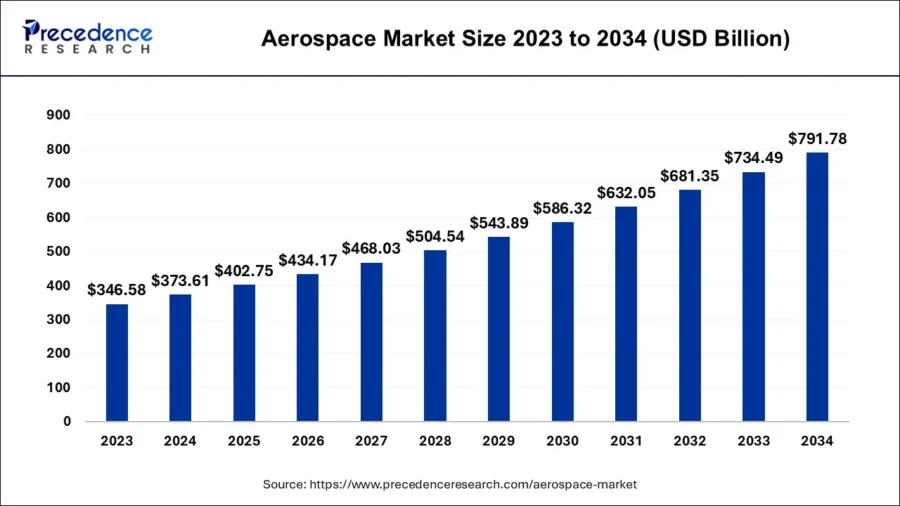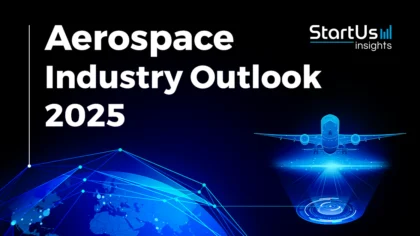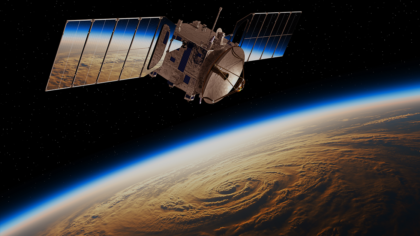The 2025 Aerospace Industry Report gives an overview of the global aerospace sector and focuses on how innovation, sustainability goals, and market demands are reshaping aircraft design, manufacturing, and operations.
It examines key trends such as next-generation aircraft development, the rise of electric and hybrid propulsion systems, and the use of digital engineering tools like digital twins and AI-powered simulations.
Growth in satellite-based services, commercial space exploration, and urban air mobility platforms is extending the industry’s scope beyond traditional aviation. The aerospace outlook also profiles emerging aerospace startups and collaborative programs influencing the sector’s future.
Executive Summary: Aerospace Market Outlook 2025
- Industry Growth Overview: According to our platform, the aerospace industry recorded 9.39% annual growth, with over 2600 startups and more than 7800 companies operating globally across various segments. The global aerospace market is projected to expand to USD 791.78 billion by 2034 at a CAGR of 7.8% during 2024–2034.
- Manpower and Employment Growth: The sector employs more than one million professionals and added over 45 000 employees last year.
- Patents and Grants: The industry reported over 90 patents and more than 3400 grants. China and the United States lead patent issuance, supported by substantial grant funding for innovation.
- Global Footprint: Major country hubs include the United States, India, the United Kingdom, Canada, and France. At the city level, aerospace activity is concentrated in Bangalore, New York City, Los Angeles, and Hyderabad.
- Investment Landscape: The aerospace sector secured more than 2600 funding rounds from over 2500 investors. Further, the average round value reached USD 122.4 million.
- Top Investors: Leading investors such as TransDigm, JPMorgan Chase, Siemens, and more have contributed a combined USD 7 billion to the sector.
- Startup Ecosystem: Innovative startups include XTI Aerospace (advanced air mobility), Reflex Aerospace (satellite solutions), Nabhdrishti Aerospace (micro gas turbines), Orbital Boost Aerospace (electromagnetic launch), and Conscious Aerospace (hydrogen powertrains).

Methodology: How we created this Aerospace Industry Report
This report is based on proprietary data from our AI-powered StartUs Insights Discovery Platform, which tracks 7 million global companies, 20K+ technologies and trends as well as 150M patents, news articles and market reports. This data includes detailed firmographic insights into approximately 7 million startups, scaleups, and tech companies. Leveraging this exhaustive database, we provide actionable insights for startup scouting, trend discovery, and technology landscaping.
For this report, we focused on the evolution of aerospace over the past 5 years, utilizing our platform’s trend intelligence feature. Key data points analyzed include:
- Total Companies working in the sector
- News Coverage and Annual Growth
- Market Maturity and Patents
- Global Search Volume & Growth
- Funding Activity and Top Countries
- Subtrends within aerospace
Our data is refreshed regularly, enabling trend comparisons for deeper insights into their relative impact and importance.
Additionally, we reviewed trusted external resources to supplement our findings with broader market data and predictions, ensuring a reliable and comprehensive overview of the aerospace market.
What Data is used to create this Aerospace Market Report?
Based on data provided by the StartUs Insights Discovery Platform, we observe that the aerospace market stands out in the following categories relative to the 20K+ technologies and trends we track.
These categories provide a comprehensive overview of the market’s key metrics and inform the future direction of the market.
- News Coverage & Publications: The aerospace industry generated over 36 000 news articles and publications last year, and reflects its active presence in the media.
- Funding Rounds: Our database tracks investment activity across the aerospace sector, documenting data from more than 2600 funding rounds.
- Manpower: The industry employs over one million people globally and added more than 45 000 workers last year.
- Patents: It recorded over 90 patents, highlighting a continued focus on technological innovation.
- Grants: The sector secured more than 3400 grants, which indicates substantial public and institutional funding for research and development.
- Yearly Global Search Growth: The global search interest in aerospace increased by 5.92% last year, showing rising public awareness and engagement.
Explore the Data-driven Aerospace Industry Outlook for 2025
Did you know the first scheduled commercial flight took place on January 1, 1914, spanning a 21-mile journey across Tampa Bay, Florida? This event marked the beginning of the modern aviation era, laying the groundwork for the aerospace industry we see today.
According to Precedence Research, the global aerospace market size is expected to reach USD 791.78 billion by 2034, growing at a CAGR of 7.8% from 2024 to 2034.

Credit: Precedence Research
Last year, the aerospace industry recorded 9.39% growth, driven by over 2600 startups and 7,800 companies contributing to innovation and production worldwide.
The sector added over 45 000 employees to a global workforce that now exceeds one million professionals across engineering, manufacturing, and emerging aerospace technologies.
Patenting activity remained modest, with more than 90 patents filed. However, grant funding demonstrated strong support, with over 3400 grants directed toward research, development, and commercialization projects.
Key country hubs include the United States, India, the United Kingdom, Canada, and France. Major city-level clusters have emerged in Bangalore, New York City, Los Angeles, and Hyderabad, highlighting regional centers of aerospace activity.
A Snapshot of the Global Aerospace Market
The aerospace industry achieved a 9.39% annual growth rate, driven by expansion across commercial, defense, and space-related segments globally.
The sector includes over 2600 active startups, with more than 270 in early development stages and 610+ companies engaged in mergers and acquisitions.

Further, there are over 90 patents filed by 90 unique applicants. The annual growth rate for patents stands at 0.1203% across various subdomains.
China leads in patent issuance, filing more than 65 patents, followed by the United States with over 10. Both countries play significant roles in advancing aerospace innovation.
Explore the Funding Landscape of the Aerospace Market
The aerospace industry has seen significant investor activity, with over 2600 funding rounds completed and more than 2500 investors involved across various company stages.
The average funding round value is USD 122.4 million, which highlights the capital-intensive nature of aerospace projects such as manufacturing, research and development, and infrastructure.
Moreover, investors have supported over 1000 companies, reflecting confidence in the industry’s growth potential and its role in transportation, defense, and space exploration.
Who is Investing in the Aerospace Market?
The top investors in the aerospace industry have collectively invested over USD 7 billion, driving growth and expansion across various company stages and technologies.

- TransDigm invested USD 2.6 billion in 8 companies.
- JPMorgan Chase allocated USD 828.7 million to 3 companies.
- Siemens contributed USD 700 million across 2 companies.
- Victory Park deployed USD 640 million in 2 companies, including a USD 73 million credit facility for Silver Airways to support fleet growth and recapitalization.
- European Investment Bank invested USD 605.5 million in 2 companies.
- Behrman Capital provided USD 515 million to 3 companies.
- ITT supported 2 companies with USD 475 million.
- Canada Pension Plan Investment Board allocated USD 310 million to 2 companies.
- AMETEK invested USD 264.2 million across 6 companies.
- Carlyle Group contributed USD 256 million to 2 companies.
Top Aerospace Innovations & Trends
Discover the emerging trends in the aerospace market along with their firmographic details:
- Advanced air mobility (AAM) is growing rapidly, with 380+ companies employing more than 74 000 people globally. The segment added over 4000 new employees last year. AAM is expanding at an annual growth rate of 37.69%, driven by developments in electric vertical take-off and landing (eVTOL) aircraft, urban air transport solutions, and regulatory advancements in aerial mobility systems.
- Aerospace robotics supports automation in manufacturing, maintenance, and inspection processes. This segment includes 180+ companies and employs more than 8000 professionals. With 540+ new employees added last year and an annual growth rate of 10.43%, robotics contributes to improved cost efficiency, precision, and safety across the aerospace value chain.
- Aerospace 3D printing focuses on additive manufacturing for lightweight components, rapid prototyping, and design optimization. The trend involves 120+ active companies, employing more than 5000 people and adding 600+ new employees last year. With an annual growth rate of 32.99%, this area plays a key role in reducing production lead times and enabling flexible design in commercial and defense aerospace projects.
5 Top Examples from 2600+ Innovative Aerospace Startups
The five innovative startups showcased below are picked based on data including the trend they operate within and their relevance, founding year, funding status, and more. Book a demo to find promising startups, emerging trends, or industry data specific to your company’s needs and objectives.
XTI Aerospace manufactures a Vertical Lift Crossover Airplane
US startup XTI Aerospace builds the TriFan 600, a vertical lift crossover airplane (VLCA) that combines helicopter-like vertical takeoff and landing with the speed, range, and comfort of a fixed-wing business aircraft. It operates using two fuel-efficient turboshaft engines that power three ducted fans—two forward-tilting and one rear-mounted—to enable vertical lift, stable hovering, and smooth transitions to high-speed flight.
The aircraft features fly-by-wire flight control systems to improve pilot responsiveness and enhance safety while reducing workload in all weather conditions. Its ducted fan design increases thrust and reduces noise levels. Further, a pressurized cabin ensures a smooth flight experience at cruise altitudes of up to 25,000 feet.
The TriFan 600 operates on helipads, airports, and short runways. XTI Aerospace targets business, commuter, and air ambulance applications to provide efficient, point-to-point mobility in diverse environments.
Reflex Aerospace makes Satellite Solutions
German startup Reflex Aerospace develops custom satellite platforms to support high-performance payloads for low Earth orbit (LEO) missions. It produces satellites weighing 75 to 500 kilograms using additive manufacturing, generative design, and an agile production process.
Each satellite is based on the OmniFlex baseline to offer a customizable bus architecture, multi-core ARM-based onboard computing (Reflex ARC), and communications systems compatible with S-band, X-band, and optical links. The platforms provide 3-axis stabilization and scalable power ranging from hundreds of watts to several kilowatts.
Reflex supports dual-use, multi-mission capabilities for applications such as optical Earth observation, synthetic-aperture radar, and satellite communications. These include space-to-ground links and quantum key distribution.
Nabhdrishti Aerospace designs Micro Gas Turbines
Indian startup Nabhdrishti Aerospace makes sustainable micro gas turbines for propulsion and power generation. Its ND400 engine features a common core architecture that supports both power and propulsion applications. The design incorporates advanced aerodynamics, recuperator systems, and sealing technology.
The engine delivers a maximum thrust of 400 N at 95 000 RPM, weighs 3.95 kg, and achieves specific fuel consumption of 37.5 mg/N-s. These specifications make it suitable for UAVs, hybrid electric flights, and light aircraft.
Further, it includes a fuel-flex combustor compatible with LNG, natural gas, hydrogen, flare gas, biofuels, and conventional fuels like diesel and jet fuel.
Nabhdrishti Aerospace uses 3D printing for component fabrication to reduce production costs and improve design precision. The turbines operate at altitudes up to 10 000 meters and reach speeds of up to Mach 0.85.
Orbital Boost Aerospace makes Orbital Electromagnetic Launcher
Spanish startup Orbital Boost Aerospace builds an Orbital Electromagnetic Launcher that uses Gauss cannon technology to accelerate payloads to orbital velocities through magnetic fields. The system relies on electromagnetism to eliminate traditional fuel-based propulsion.
The launcher places a loaded pod into low Earth orbit using a conventional rocket. A sheath equipped with cold propulsion, telecommunications systems, and a ferromagnetic head aligns with the launcher to enable precise acceleration.
The control system calculates and delivers the required velocity to ensure the pod follows a predetermined trajectory based on orbital mechanics. Orbital Boost Aerospace advances sustainable and accessible space exploration and commerce.
Conscious Aerospace develops Hydrogen Aircraft Powertrain and Storage Systems
Dutch startup Conscious Aerospace designs the Hydrogen Aircraft Powertrain and Storage Systems (HAPSS), a retrofit solution that converts existing turboprop aircraft to hydrogen-electric propulsion for zero-emission flight.
The system consists of five components: a liquid hydrogen storage and distribution system, fuel cells with power management, an electric propulsion unit, thermal management, and integrated control and display modules.
It replaces conventional gas turbines with a fully electric drive powered by hydrogen fuel cells. These cells convert chemical energy into electricity to operate the propulsion system.
The startup offers two configurations: HAPSS 2100 provides 2.1 MW for aircraft seating 30 or more passengers, while HAPSS 4000 delivers 4.0 MW for aircraft seating 60 or more passengers.
Conscious Aerospace focuses on delivering hydrogen-based propulsion systems for regional air transport to support sustainable aviation.
Gain Comprehensive Insights into Aerospace Trends, Startups, and Technologies
The aerospace industry in 2025 continues to grow steadily, supported by innovation, workforce expansion, and rising global investment. Trends such as advanced air mobility, 3D printing, and robotics are reshaping production processes and mobility models.
Get in touch to explore 2600+ startups and scaleups, as well as all market trends impacting aerospace companies.




![Explore the 10 Top AI Solutions for the Space Industry [2025]](https://www.startus-insights.com/wp-content/uploads/2025/04/AI-Solutions-for-Space-Industry-SharedImg-StartUs-Insights-noresize-420x236.webp)

![Discover the Top 10 Satellite Industry Trends & Innovations [2025]](https://www.startus-insights.com/wp-content/uploads/2025/04/Satellite-Industry-Trends-SharedImg-StartUs-Insights-noresize-420x236.webp)




